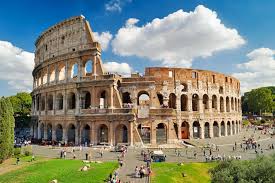Discovering the World’s Most Captivating Attractions
From iconic landmarks to natural wonders, the world is filled with attractions that leave visitors in awe. Whether you’re a history buff, nature enthusiast, or adventure seeker, there’s something for everyone to explore and admire. Let’s take a journey through some of the top attractions around the globe.
The Eiffel Tower, Paris
No list of attractions would be complete without mentioning the Eiffel Tower in Paris, France. This iconic iron lattice tower stands tall as a symbol of romance and architectural brilliance. Visitors can ascend to the top for panoramic views of the City of Light, making it a must-see attraction for travellers from around the world.
The Great Wall of China
Stretching over 13,000 miles across northern China, the Great Wall is an ancient marvel that showcases human ingenuity and determination. Built over centuries to protect against invasions, this UNESCO World Heritage Site offers visitors a glimpse into China’s rich history and breathtaking landscapes.
Machu Picchu, Peru
Nestled high in the Andes Mountains of Peru, Machu Picchu is a mystical Incan citadel that continues to captivate travellers with its beauty and mystery. Surrounded by lush greenery and steep cliffs, this archaeological wonder provides an unforgettable experience for those willing to trek through its ancient ruins.
The Grand Canyon, USA
Carved by the Colorado River over millions of years, the Grand Canyon in Arizona is a natural masterpiece that showcases the Earth’s geological history. Visitors can marvel at its vastness from viewpoints along the rim or venture down into its depths for hiking adventures that reveal stunning rock formations and vibrant colours.
Sydney Opera House, Australia
Perched on Sydney Harbour like a set of billowing sails, the Sydney Opera House is an architectural gem that has become synonymous with Australia’s cultural identity. Home to world-class performances and events, this iconic venue offers visitors a chance to admire its design up close or take in sweeping views from nearby vantage points.
Conclusion
These are just a few examples of the many incredible attractions waiting to be explored around the world. Whether you’re drawn to man-made wonders or natural beauty, each destination offers a unique experience that will leave you inspired and enriched by your travels.
Exploring Attractions: Top Tourist Spots, Types, and Their Importance in the UK
- What is the number 1 tourist attraction in the UK?
- What are 3 natural attractions?
- Why are attractions important?
- What is meant by tourist attractions?
- What does attractions mean in tourism?
- What are unusual attractions?
- What are the four types of attractions?
What is the number 1 tourist attraction in the UK?
The number one tourist attraction in the UK is often considered to be the historic Tower of London. This iconic fortress, palace, and former prison located on the north bank of the River Thames in central London, has a rich history dating back over 1,000 years. Visitors flock to the Tower of London to explore its medieval architecture, view the Crown Jewels, and learn about its fascinating past as a royal residence and place of imprisonment. With its captivating stories and impressive architecture, the Tower of London continues to be a top attraction for tourists seeking a glimpse into England’s royal heritage.
What are 3 natural attractions?
Natural attractions are wonders of the Earth that never fail to inspire awe and wonder in visitors. Three notable natural attractions include the majestic Victoria Falls in Africa, where the Zambezi River plunges dramatically over a cliff, creating a breathtaking spectacle of mist and rainbows. The serene beauty of the Northern Lights in Scandinavia is another mesmerising natural phenomenon, where colourful ribbons of light dance across the night sky, captivating all who witness this celestial display. Lastly, the vast and diverse Amazon Rainforest in South America beckons adventurers with its lush biodiversity, offering a glimpse into a world teeming with exotic flora and fauna unlike anywhere else on the planet.
Why are attractions important?
Attractions play a vital role in enriching our lives by offering experiences that educate, entertain, and inspire. They serve as cultural landmarks that preserve history, showcase artistic achievements, and celebrate natural beauty. Attractions also contribute to local economies by attracting tourists, creating jobs, and supporting small businesses. Beyond economic benefits, attractions foster a sense of community pride and identity, drawing people together to appreciate shared heritage and create lasting memories. Ultimately, attractions are important because they enhance our quality of life, promote cultural exchange, and encourage exploration of the world around us.
What is meant by tourist attractions?
Tourist attractions refer to places, landmarks, or activities that draw visitors from near and far due to their unique appeal, historical significance, natural beauty, or cultural importance. These attractions are designed to captivate and entertain tourists, offering them a glimpse into the essence of a destination’s identity and charm. From iconic monuments to scenic landscapes and immersive experiences, tourist attractions play a vital role in shaping the travel experience by creating lasting memories and fostering a deeper understanding of the world around us.
What does attractions mean in tourism?
In the context of tourism, attractions refer to the various points of interest or places that draw visitors to a particular destination. These attractions can encompass a wide range of experiences, including historical landmarks, natural wonders, cultural sites, entertainment venues, and recreational activities. They serve as the main reasons for travellers to visit a specific location and play a crucial role in shaping the overall tourism experience. Attractions not only showcase the unique characteristics of a destination but also offer opportunities for exploration, learning, and enjoyment for tourists seeking memorable experiences during their travels.
What are unusual attractions?
Unusual attractions are the hidden gems and offbeat wonders that often lie beyond the typical tourist hotspots. These unique sites offer a quirky and unconventional experience, showcasing the creativity, eccentricity, or historical significance of a place in unexpected ways. From bizarre museums to peculiar landmarks, unusual attractions challenge visitors to step off the beaten path and explore the lesser-known corners of a destination, providing a refreshing and memorable perspective on local culture and heritage.
What are the four types of attractions?
When discussing attractions, it is common to categorise them into four main types: natural attractions, cultural attractions, historical attractions, and recreational attractions. Natural attractions include stunning landscapes, wildlife reserves, and geological wonders that showcase the beauty of the natural world. Cultural attractions encompass museums, art galleries, and heritage sites that offer insights into a region’s artistic and societal achievements. Historical attractions focus on landmarks, monuments, and archaeological sites that preserve the past and tell stories of bygone eras. Recreational attractions cater to leisure activities such as theme parks, beaches, and sports facilities that provide entertainment and relaxation for visitors of all ages. Each type of attraction offers a unique experience for travellers seeking to explore the diverse offerings of destinations worldwide.




